How to Sell Online Courses From Your Own Website
Creating and selling courses have made earning a recurring income a tangible reality for many creators. Be it educators, entrepreneurs, or niche experts, selling courses is a great way to share your expertise and build niche authority.
No matter what phase of the buyer’s journey your customer is in, there’s always a course to guide them. And what is better than selling your courses from your own website? While course marketplaces can lower your revenue, the imposter syndrome is a given!
Selling from your website offers you complete control over your course content and revenue.
Here’s what you’ll learn here:
- How profitable is it to sell courses online
- Choosing the right platform for selling courses
- How to sell online courses from your website
- How to build a sales funnel for your course
What are the Benefits of Selling Online Courses From Your Website?
Yes, selling courses online is profitable, while the profits wildly vary based on the value offered.
You can maximize the profits by selling courses from your website in the following ways:
- Complete ownership: You gain complete control over ownership and branding of your course when selling from your website. For instance, choose the right mix of course format and customizations to stand out in the market.
- Reduce cost: You don’t have to spend a dime on additional course platforms or course marketplaces and gain complete control over student data and branding.
- Earn more revenue: Course-creators can keep the entire revenue without losing profits to high platform commissions. For example, Udemy takes 63%-3% of revenue from your course sales and Coursera retains 20% of your course earnings.
For example, Jenna Kutcher called the “Digital Marketing Queen” has created a multi-million dollar empire from her marketing expertise. She transforms her expertise into amazing courses and sells it from her website.

Kutcher sells different courses, including Instagram Lab, Pinterest Lab, Content Lab from her website.

- Decide your own price point: Gain complete control over pricing and escape the fierce competition from other course-selling creators. Opt for value-based pricing, where you define your price point based upon the course’s worth.
- Leverage a direct channel: When selling courses from your website you can capitalize from the existing traffic in your space. Capture and nurture leads through email campaigns and newsletters and grow your audience.
While creating a course can generate lucrative revenue, it’s all about timing, credibility, and your target audience. So, if you find the sweet spot, everything becomes easier.
-Justin Welsh
How to Sell Online Courses From Your Website?
In this blog, we pick up the best approach to sell online courses and explain how to do it the right way!
Let’s quickly walk you through the steps to start selling courses from your website:
- Decide a profitable niche
- Research your target audience
- Course creation
- Build a website
- Decide your course pricing
- Increase your course value
- Market and sell your course
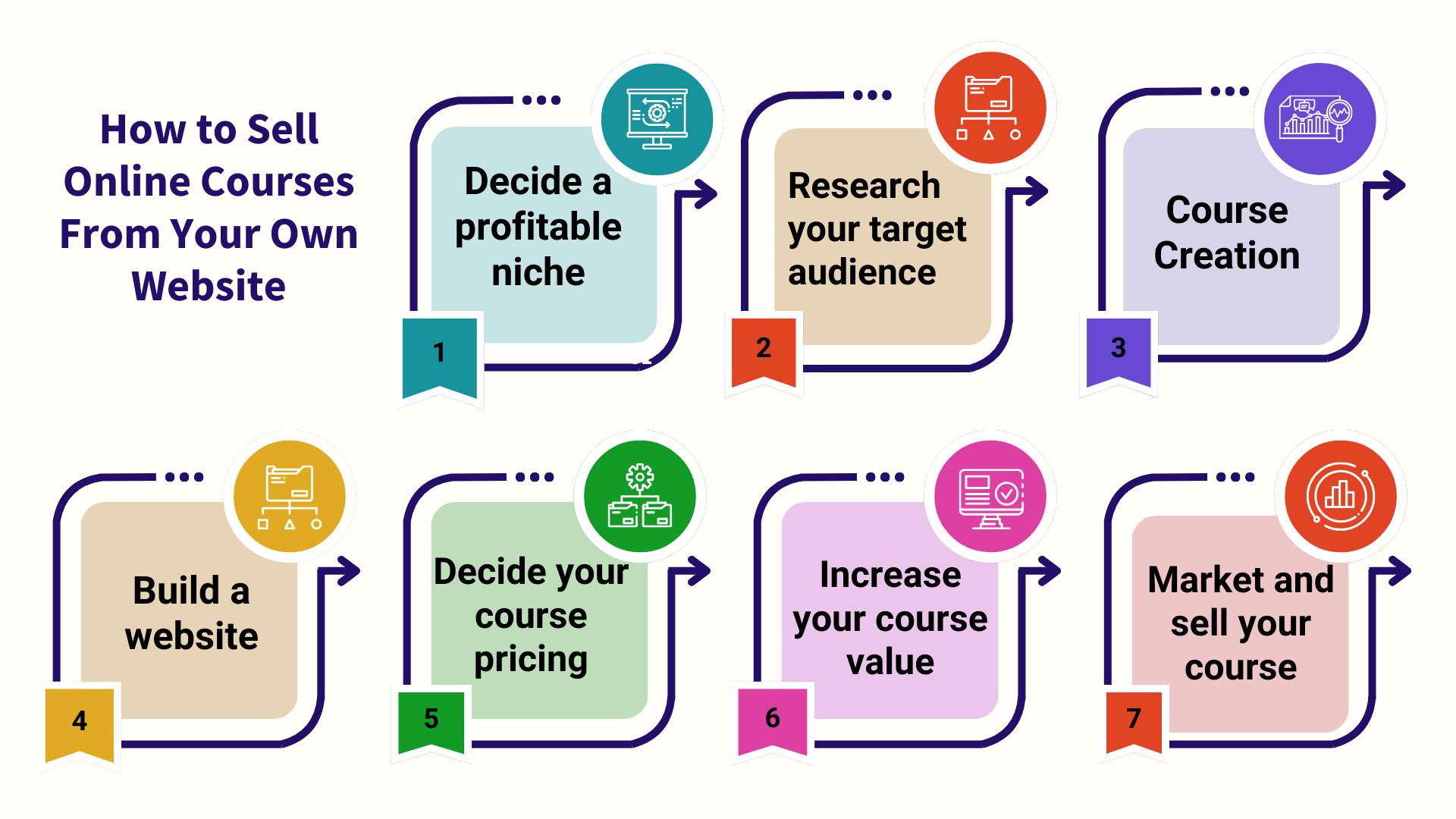
Step # 1: Decide a Profitable Niche
Now, you have made up your mind to create your course. The first thing you need to do is pick up a profitable niche to find success with your course. This involves tapping into a segment of your niche and also settling on a target audience.
Choosing a niche helps have several benefits: low entry barrier, authority, easier marketing.
For example, within “computers and technology,” there are several segments, such as software development, cloud computing, cybersecurity, cryptocurrency, etc. If you pick software development, you could further narrow it down to mobile or web development.
Here are a couple of steps to get you started:
Start with Your Knowledge & Passion
Do you have expertise or skills in a specific niche? Or are you passionate about a specific niche?
Focus on your expertise and knowledge to prove your subject matter expertise. Look into your past experience, success stories, or testimonials to analyze what you’re good at. Identify the industry gaps and align your industry expertise with them.
Whether you already have an existing audience or are willing to share your niche expertise, people are always willing to hear from experts.
For example, if people want to increase their productivity, they’ll learn from someone like Ali Abdaal who has created a YouTube empire with 6.25 million subscribers in the field.
His flagship productivity masterclass and “Part-time YouTuber Academy” has found considerable success. Here the productivity pro, dispels proven strategies and techniques with an evidence-based approach from the medical field.
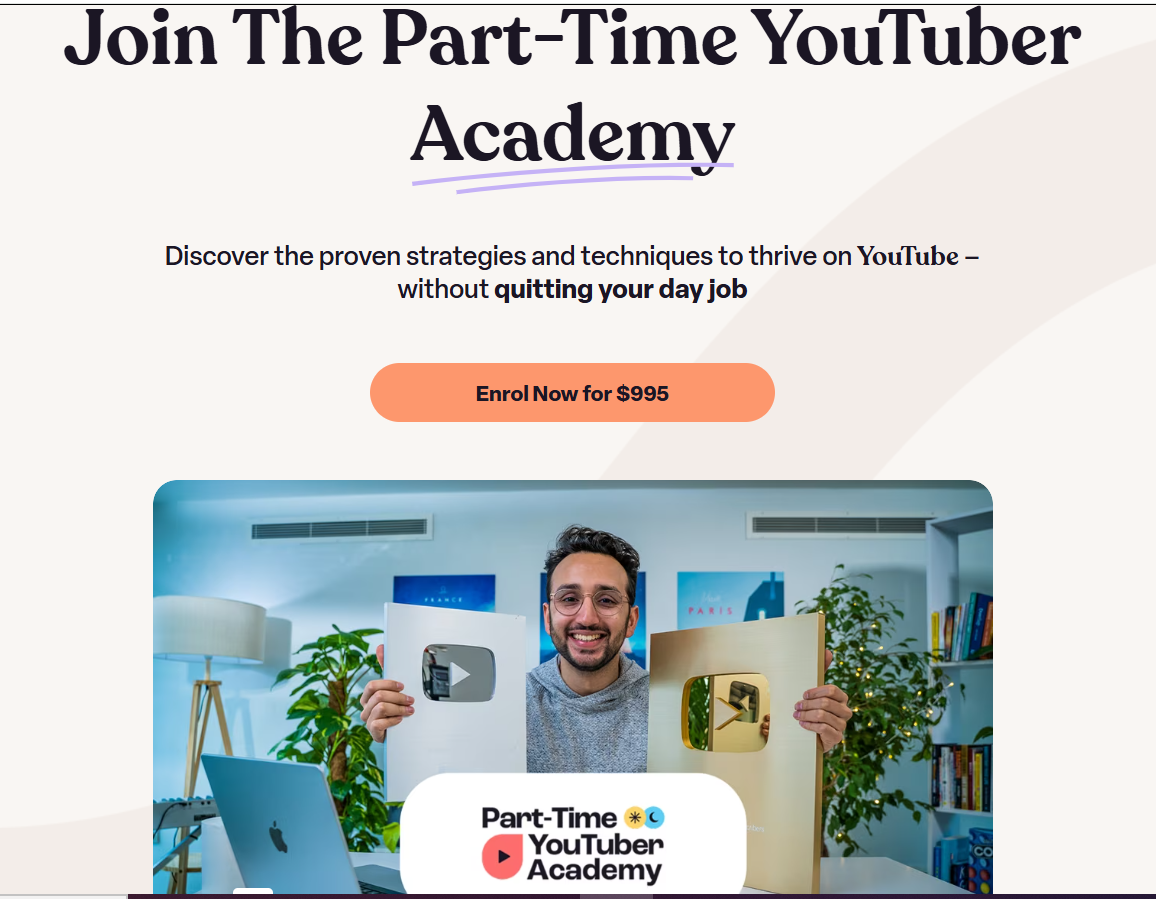
And even if you’re not an expert, it’s okay; you need something valuable to offer!
Analyze the Search Engine Volume for the Specific Sub-Niche
Search volume is simply the number of times users are actively searching for a specific key phrase. Analyzing search volume traffic and trends helps you understand whether your niche is monetizable enough!
Use tools like SEMRush, Ahrefs, and Google Keyword Planner to check search volume and keyword difficulty. This helps you optimize your course content with user intent and identify profitable niches.
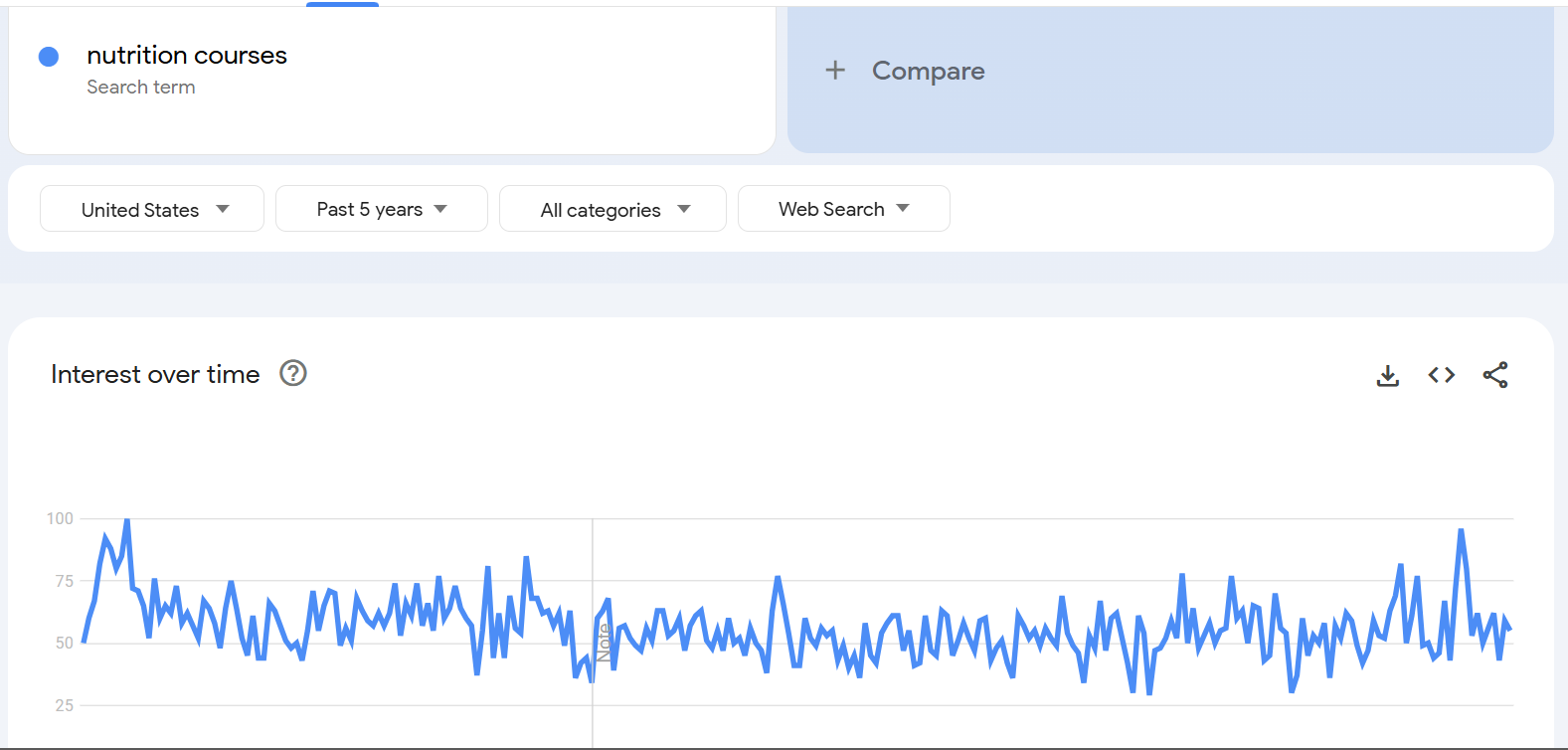
Use tools like Google Trends, Exploding Topics and BuzzSumo to identify emerging niches, user behaviour, and market shifts.
Examine the Engagement Level in Online Communities
Another way to determine whether your course niche is a good one to capitalize on is to see if people are discussing it online.
Evaluate the engagement across online communities, Facebook groups or Reddit. Look what’s hot on niche-relevant groups. Also, keep an eye out on the discussions on social media like X, Facebook, Instagram, LinkedIn.
Check the Market Demand and Competition
Competitor analysis is one of the best ways to identify if a specific niche is profitable enough! A potential high market demand indicates a massive audience potential and more revenue.
Identify the top 2-3 competitors in your niche and research their pricing, course content, customer reviews, keywords, traffic, and promotional strategies. This will help you identify potential opportunities and industry gaps.
Step # 2: Research Your Target Audience
Many course creators dive directly into course creation without knowing their audience well. This results in a generic course that’s just digital dust!
Audience research helps to create a course that addresses the audience’s pain points and offers a timeless solution.
Consider factors like your audience’s age, location, language, pain points, interests, and income levels. Based on these points, create a detailed buyer persona and consider goals and motivation.
Ask the following questions to craft a course pitch-perfect course:
- Who would you like to serve?
- What are their expectations, goals, and pain points?
- What is my course’s unique selling proposition?
- What are their preferred marketing channels?
- What are their preferred learning styles?
- What’s the reason to purchase the course?
Luckily, you have several tools at your disposal. Client interviews, surveys, SEO tools, customer data, and competitors are perfect audience research tools.
Step # 3: Course Creation
Now, let’s head to course creation! Remember, your main goal shouldn’t be money; focus on offering value first.
Pick a Course Idea
Pick a unique yet marketable course idea. While there will always be someone who knows more, this should not stop you from choosing the topic.
Also, facing the imposter syndrome is quite normal, given there will be courses on the same topic. Moreover, your ability to communicate your expertise, ideate solutions and measure their progress is unparalleled.
You can overcome these challenges by choosing a niche-focused topic rather than a broad one. If you’re creating courses in fitness and training, target popular topics like “sports nutrition,” “science-based workouts,” or “functional training.”
Also, start with something you have better-than-average knowledge of and people generally approach you for. This could help you connect the dots and demonstrate all your expertise, credibility, insight, and passion.
Validate Your Course Idea
“Will my course sell?”
This is a definite question every course creator stumbles upon. The antidote is — to validate your course idea.
One of the best ways to validate your course is to pre-sell the idea. Create a landing page or, better yet, an X post sharing your course idea and monitoring reactions.
Highlight the benefits & features of your course and make it as convincing as possible.
Further, the Google and YouTube search, forums, subreddits, and social listening tools are great for validating your course idea before launching.
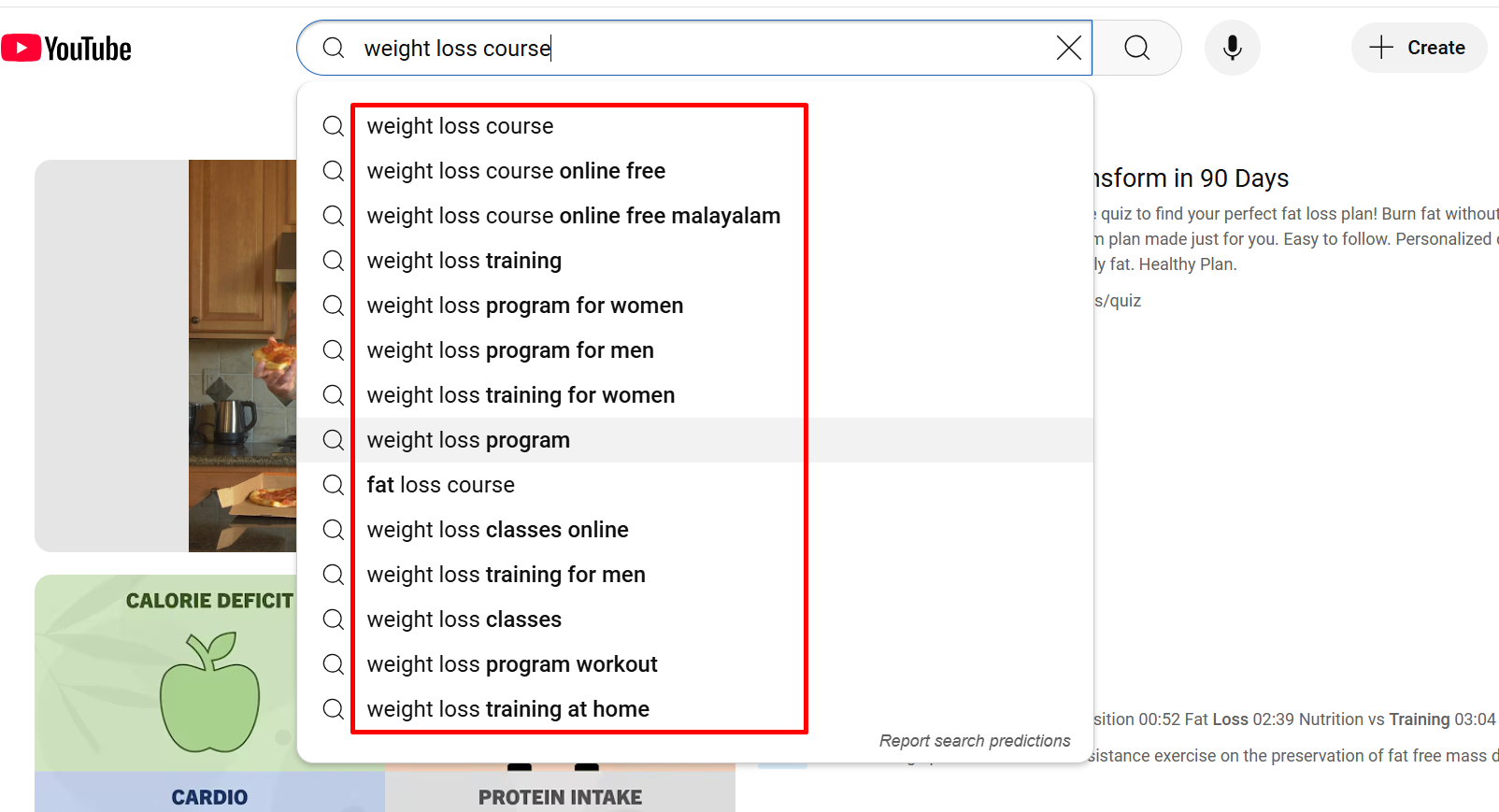
Choose a Course Format
Your course format might differ based on your goals, delivery methods, and how you wish to engage your learners. For example, you might choose to offer a self-paced course or blend live courses to guide your learners.
Your courses might be adopted either of the formats:
- Mini-course – These short and snappy courses typically range from 1 to 2 hours and focus on a specific skill. You can create a mini course to test a bigger course in the pipeline or attract lead magnets. These bite-sized courses are action-oriented and align with a specific problem and specific audience.
- Multi-day – An extension of a mini-course, a multi-day course generally lasts a few days and offers in-depth knowledge on a specific topic. The entire course might be divided into separate modules and include live classes and supplementary resources like worksheets and checklists. This could be workshops, training programs, or course series.
- Master Class – The last course format is an in-depth course spanning 40 to 60 hours, typically taught by niche experts. These courses are priced on the higher side and include the community component.
If you’re a first-time course creator, you should start with mini-courses, then multi-day and attempt the masterclasses in the end.
Create Course Content
You might have come up with a great course idea, but creating the course content involves the actual work!
- Start with an outcome– Why? Because that sets the groundwork for the rest of your course — content formats, approach, learning materials.
- Break the content into modules and lessons – Work backwards to determine the essential modules to achieve the outcome. Identify the core themes and ideas and create relevant modules.
- Think about different structure patterns – A step-by-step guide, topic-based, problem-solution, weekly course structure are few structure patterns
- Break down each module into lesson formats – Group related ideas & coherent sections into each section.
- Enrich each lesson with different content types – Choose from pre-recorded videos, screencasts, text content, downloadable content, and workbooks depending on the course type. For instance, Ali Abdaal’s Part-time YouTuber Academy is a great mix of video material, frameworks, checklists, frameworks, and templates.
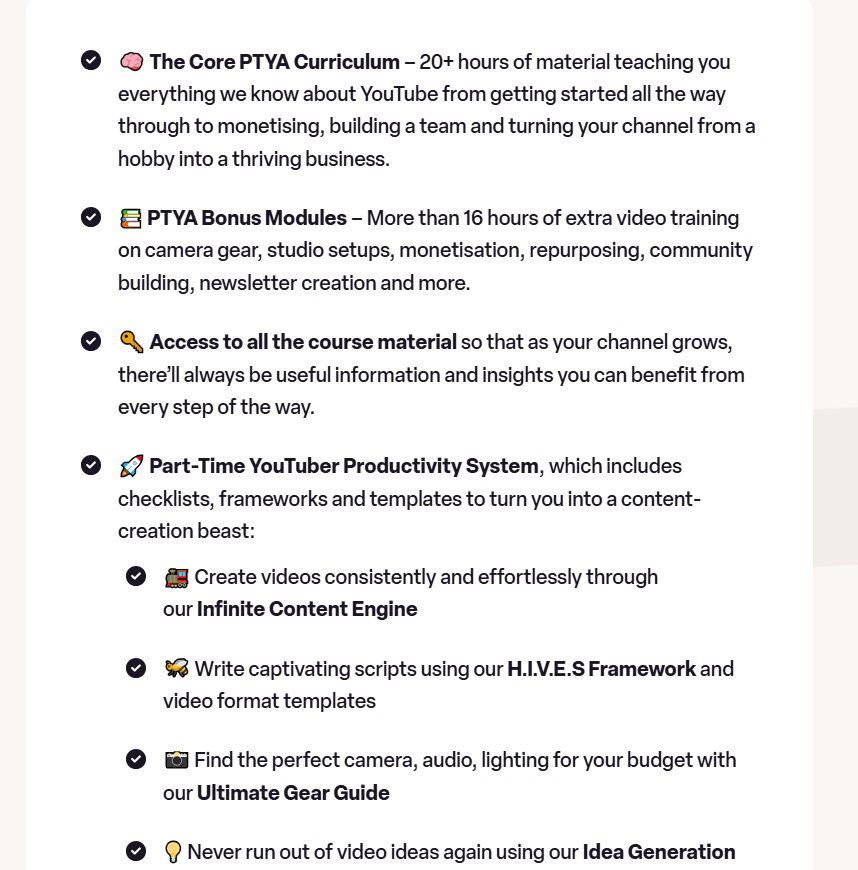
💡Tip:Keep your courses short. Ideally, 45 minutes to an hour is the right duration preferred by learners. But, masterclasses and multi-day courses can extend up to 4 hours.
Creating high-quality course content is essential. Here are the bare essentials to record high-quality videos:
- Camera and equipment
- Lighting
- Audio
- Tripod
- Screen Recorder
- Editing software
🎥 Attempting a course video for the first time? Take a look at our detailed blog on how to record online course videos.
Step # 4: Build Your Own Website
If you already have a website, you can simply host the course using a dedicated plugin. Otherwise, you need to create one if you have development expertise. There are several ways to create your own course-selling website: CMS like WordPress plugins, website builders, building from scratch.
You can get your website up and running by getting these few essentials done:
-
Purchase a Domain
Your domain name is the address or URL of your website that helps locate your website. When someone types your domain name on the search bar, it sends a request to the web server, and they get your website.
Choose a name that’s unique and memorable. Domain.com, Namecheap,and Bluehost are a few popular domain providers. Later, you can just add a dedicated page for your course.
-
Choose Web Hosting
Once you get a good domain, it’s time to host your website. Web hosting offers a digital space to store your site’s data and access it when required. Choose a reliable and secure hosting provider.
Look for scalability, storage, performance, and data centre locations and pick a hosting plan as per business needs. Web hosts like Bluehost offer both web hosting and domain services, this makes your job easier.
-
Set up Your Website
If you are using WordPress, first install WordPress into your website. Some web hosts get the installation done for you, or you might need to install the WordPress app. Next, choose a perfect responsive WordPress theme with unique features that fits your business needs. Now, integrate a WordPress LMS plugin to host your course on the website.
TutorLMS, LearnPress, LearnDash, are a few LMS plugins that allow integrating quizzes, assignments, and certifications.
Another way to build your website is using website builders like Hostinger, Wix, and Squarespace. The intuitive drag-and-drop editors help you customize and design your website layout.
The last method is to build from scratch, which requires coding skills! Of course, you can outsource it to the development team and get your website ready! They would charge you an hourly price or a fixed project fee. However, the project might require an extensive timeline and cost.
-
Create the Essential Pages
Add all the necessary pages so learners get the required course information. The essential webpages are the homepage, sales page, payment page, privacy policy and terms and conditions. Integrate a trusted payment gateway like Stripe or PayPal to manage course transactions.
-
Ensure Advanced Security & SSL settings
Get an SSL certificate that enables HTTPS encryption for all user interactions. This protects the website from security breaches and is necessary for payment compliance.
Step # 5: Decide Your Course Pricing
So, what’s your sweet spot to price your courses?
While finding that spot in the first place is difficult, it’s much of a guessing game. To find the right price point, you need to go through a lot of trials and errors.
Mostly the pricing depends on the course type and format. A mini-course is either free or low-cost, while a masterclass is expensive.
Consider the following factors to determine your price point:
- Cost required to create, market and host the courses
- Niche and topic
- Competitor pricing
- Experience or authority
- Target audience’s income
You can price your course in the following ways: one-time fee, multiple payments, subscriptions or memberships (monthly recurring payments).
Offer value-based pricing — perceive the value based on your course’s worth, rather than competitor or course-creation costs. This works best when you are selling from your website.
Most importantly, you can keep 100% of your revenue without the hassles of any platform fees or commissions.
Step # 6: Increase Your Course Value
You have put all the expertise, insights, and ideas into your course. You are thrilled by the reviews from your course. So, surely you have won their trust!
What next? Now, you need to take your course to the next level and offer them more value!
Perhaps, you have got a new lesson or an existing course that received a positive response. A powerful way to offer more value and earn additional income is — upselling.
No pushy promotional tactics or salesy landing pages; just find a strategic place to upsell. This could be thank you pages, shopping carts, or welcome emails. Offer course bundles or one-click upsells to monetize with minimal effort!
Other ways to add extra value include:
- Certificates
- Bonus
- Live consultations
- Community access
- Coaching sessions
- Sell digital products
Thus you can enhance the overall learning experience!
For example, Marie Forleo is an entrepreneur, coach, and course-creator who helps entrepreneurs to find more success and impact with their business. The “Time Genius work” is one of her powerful courses helping entrepreneurs to master time management and be more productive.
Apart from her core training modules she offers a supplementary live group coaching with her, and personalized support from her expert coaches. This increases the value of her course.
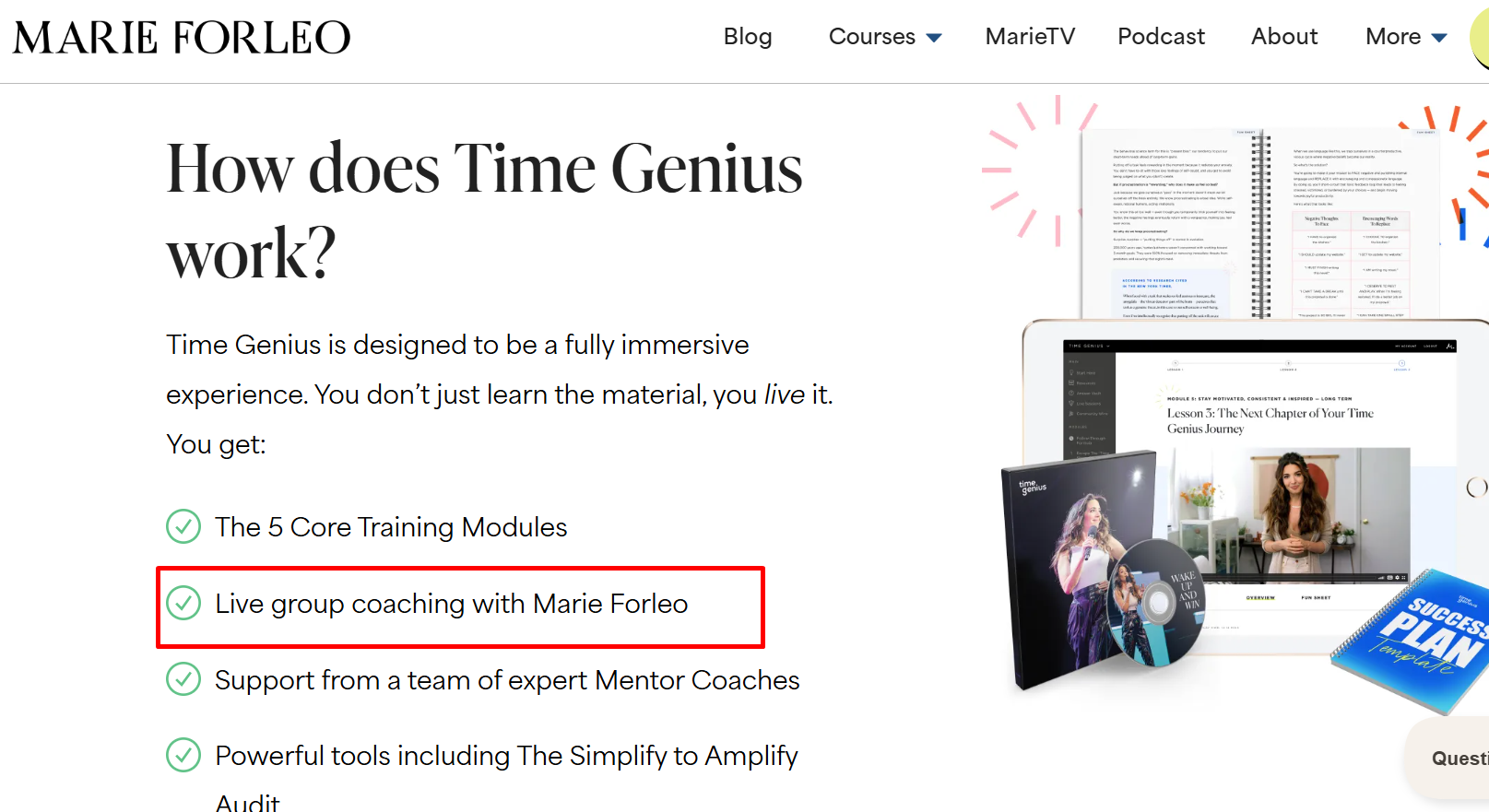
Step # 7: Market and Sell Your Course
You have created a remarkable course, but that’s not enough! You need to make sure your course is visible to your audience and spread the word!
Remember, your course is on your website, so you have to drive more traffic to your website. Next, you can convert this traffic into real customers!
Let’s look at the different tried-and-tested strategies to market your courses!
- Landing page – The most straightforward way to promote your course is a landing page. A dedicated landing page helps to direct your platform visitors to more course signups. Highlight your course benefits, pain points, and client testimonials in a single page. This helps to reduce the bounce rate of your course page!

- Weekly webinar – Unlike other salesy tactics, webinars are cost-effective and showcase your expertise. Use webinars as lead magnets; this increases the likelihood of course conversion significantly. The more webinar signups, the more course enrollments!
- Build an email list – Set up an email marketing funnel for those landing on your course page. While all the visitors landing on your course page won’t sign up, use email lists to share updates, discounts, and new course updates.
- Podcast – Podcasts have become a global phenomenon! Make guest appearances on niche-relevant podcast channels, explore your problem-solution narrative, and drop-in some quick-win nuggets of wisdom!
- Social media marketing – Build hype on social media platforms like X, LinkedIn, Facebook, Instagram. Create anticipation through polls, pre-sell your course, post short-videos, and share social proof.
- Paid ads – Run paid ads on Google ads, YouTube ads and Facebook ads for targeted reach. For example, Google ads can make your course appear when customers search specific keywords.
How to Build a Sales Funnel for a Course on Your Own Website?
Finally, you have crafted a masterpiece that demonstrates your expertise and a keen desire to help people find solutions! Creating a course is an achievement, but getting your ideal clients enrolled in it is a remarkable feat!
So, if you are struggling with course sales, don’t be disappointed!
A marketing funnel can set up momentum for your business, so you don’t have to give up on your dream! Build an effective sales funnel to increase visibility and higher engagement and eventually maximize dreamy sales conversions!
Let’s get into the steps to build a sales funnel for your course!
1. Identify Your Target Audience’s Problem
Forums, quora pages, subreddits, Facebook groups, surveys can offer you valuable insights & pain points your audience are facing.
2. Offer Free Content Highlighting the Problem
Create blogs, short videos, and podcasts with a problem-solution-styled approach to solving the problem. There, you have nailed a touchpoint (interaction between customer and business) to take them down the funnel.
3. Build Your Email List
It’s time to build your email list and offer them gated content like ebooks, webinars, and whitepaper. Place the CTA strategically in your blog post (near top, middle, or bottom) to capture leads.
4. Send a Welcome Email
You’re almost there! Use Mailchimp or SendGrid to start an automated mail sequence when a prospect signs into your email list. Offer them the free resource you promised while signing up. You can send them a series of emails and finally promote your course.
Well, that’s a wrap! And that was our detailed guide on how to build and sell a course on your own website!
Alternative Ways to Sell Online Courses
Online Course Platforms
From course creation to student engagement and dynamic marketing and sales tools, online course platforms offer convenience.
Below are some popular course platforms:
- Thinkific – It is one of the top course platforms for creating and selling courses and turning your expertise into revenue. From unlimited courses to customized learning paths and multiple payments, Thinkific offers a well-rounded user experience.
- Kajabi – An all-in-course platform, Kajabi offers comprehensive tools for managing everything from course creation to marketing and sales. Its core features include email marketing, sales funnels and detailed analytics.
- Teachable- It is an online platform with tools to create, host, and market courses and coaching. Teachable’s dynamic features include a drag-and-drop course builder, drip content, branding, payment and a powerful checkout.
⚡Related Reads:
Course Marketplaces
Course marketplaces like Udemy and Coursera have been the go-to platforms for course creators, to the extent that they were synonymous with course creation. These platforms offer dynamic tools for course creation and discovery, payment management and customer support.
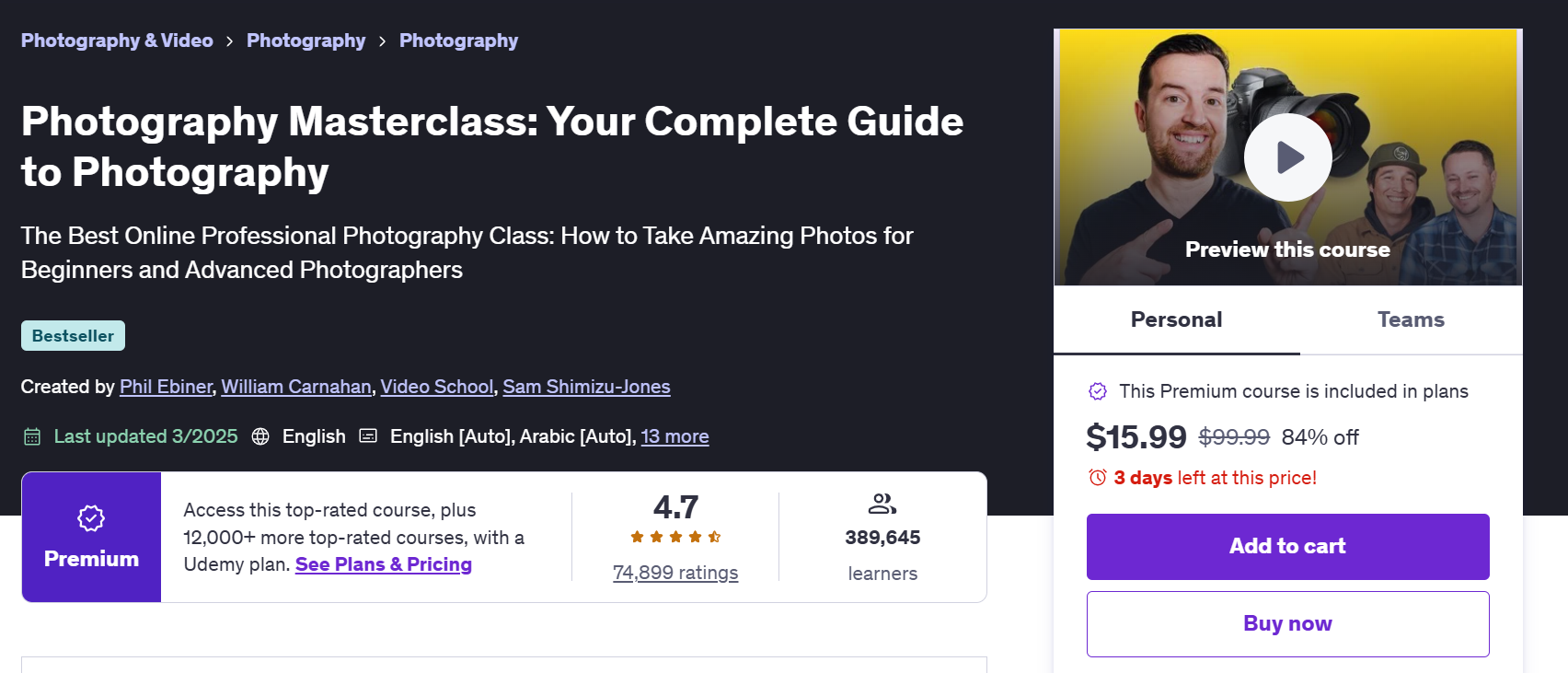
The downsides of these platforms are high commissions, limited control over branding and pricing, and competition.
For example, Udemy retains 63%-3% of instructor revenue, depending on how the course is sold.
Selling Courses Through Social Media
Social media is a powerful tool to sell your courses and build your brand! However, the one place people often struggle is making course sales.
Aim for a solid social media plan that offers valuable content and promotional strategies to build a loyal audience. Instagram, YouTube, Facebook, LinkedIn, and X are great platforms for those amazing course sales.
Before launching your course, build hype with interactive X (Twitter) polls. This could be a simple poll to know “the course topic the audience prefer.”
Share course snippets such as detailed video lessons from your course and upload it on YouTube. Don’t forget to offer lead magnets, free guides, or webinars to capture leads!
For example, here’s how Dan Koe (writer & internet personality) sells his course on YouTube:
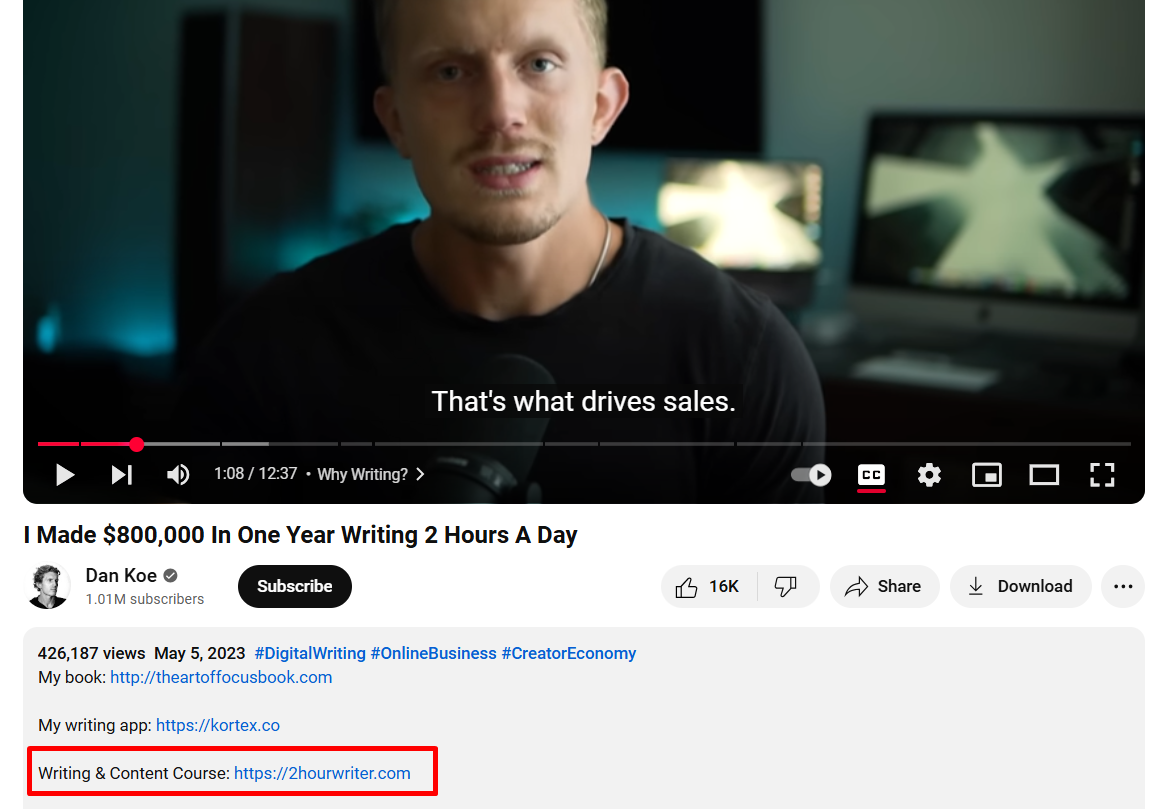
Ready to Start Selling Online Courses From Your Own Website?
Whether you’re finding a way to escape the 9-to-5 grind or trying to build authority in your niche, selling courses offers a lucrative revenue stream! Online course platforms might offer convenience by managing the strenuous hosting and payment bits, but they churn your profits as well!
Hence, selling online courses from your own website is the best option, as it offers complete control over your business. You’re the “captain of your ship” as you decide to price and gain complete control over your course content without struggling with the stiff competition.
We hope this guide on how to sell online courses from your website helps you find answers to scale your course business!
FAQ-Related to How to Sell Online Courses From Your Website
1. How do I create an online course on my own website?
Here’s the step-by-step guide to creating a course from your website:
- Step 1: Decide a profitable niche
- Step 2: Research your target audience
- Step 3: Course creation
- Step 4: Build your own website
- Step 5: Decide your course pricing
- Step 6: Increase your course value
- Step 7: Market and sell your course
2. How do I sell courses with no followers?
Follow these steps to sell courses when you have a small audience:
- Run paid ads on Google, Facebook and YouTube.
- Incorporate SEO strategies to increase visibility on search engines
- Use leads magnet to grow your audience
- Engage with your audience on social media
3. How do you drive more traffic to my own website?
To drive more traffic to your courses, create high-quality content, build an email list, leverage social media marketing, host a live webinar and promote your course on the blog page.
4. What are the most popular payment gateways for your course-selling website?
Stripe, Paypal, Authorize.net, and Verifone are some popular payment gateways to integrate with your course-selling website.





